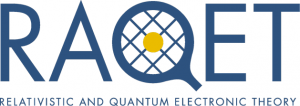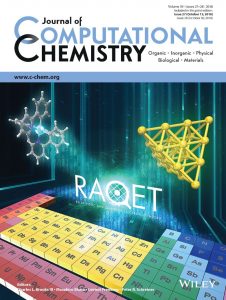3-B.Development of practical two-component relativistic program
RAQET

In 2012-2017, Nakai’s Group promoted a research project called “Innovative Functional Material Design Opened by Relativistic Electronic Theory” in the JST-CREST “Elemental Strategy” Research Area (Research Supervisor: Dr. Kohei Tamao). The element strategy aims to utilize ubiquitous elements while refraining from using rare and regulated elements. Because most of these elements are heavy elements at the bottom of the periodic table, the relativistic effect cannot be ignored for the quantum chemistry calculations.
In order to theoretically promote elemental strategy, we thought that a paradigm shift to relativistic quantum chemistry theory, which fused quantum mechanics and special relativity, was indispensable. For this purpose, Nakai’s Group developed the local unitary transformation (LUT) method to efficiently construct the spin-independent two-component relativistic Hamiltonian (a well as the spin-free one-component relativistic Hamiltonian). In addition, by combining the divide-and-conquer (DC) method and the LUT method, linear scaling was achieved at all steps of the two- (or one-) component relativistic calculations. From the viewpoint of “Social Implementation of Computational Chemistry”, we implemented these original methods in the GAMESS program in order to make them widely available to the public.
However, many quantum chemistry programs, including GAMESS, have a history of developing as numerical solutions to non-relativistic Schrödinger equations. Therefore, many variables used in the program are defined in real type. Although spin-free one-component relativistic calculations can be implemented with simple changes, spin-dependent two-component relativistic calculations, including spin-orbit interactions, require significant changes using many complex variables. Therefore, in the JST-CREST project, we decided to develop an original two-component relativistic program, Relativistic And Quantum Electronic Theory (RAQET), from scratch, taking advantage of several original methodologies.
After the project (in 2019), RAQET program was released to the public. User registration for the RAQET program can be done from our web site. For the functions of the RAQET program, see the English commentary article (J. Comput. Chem., 39, 2333 (2018), Fig. 3-B-1) and the Review (in Japanese) article (J. Comput. Chem. Jpn., 18, A6 (2019)).

Fig. 3-B-1
Key Literature
<RAQET Program>
- M. Hayami, J. Seino, Y. Nakajima, M. Nakano, Y. Ikabata, T. Yoshikawa, T. Oyama, K. Hiraga, S. Hirata, H. Nakai, “RAQET: Large-scale two-component relativistic quantum chemistry program package”, J. Comput. Chem., 39, 2333 (2018).
<Review>
- H. Nakai, “Development of linear-scaling relativistic quantum chemistry covering the periodic table”, Bull. Chem. Soc. Jpn., 94, 1664 (2021).
<日本語解説>
- 五十幡 康弘, 吉川 武司, 中井 浩巳, “相対論的量子化学計算プログラムRAQETの公開”, J. Comput. Chem. Jpn., 18, A6 (2019).
